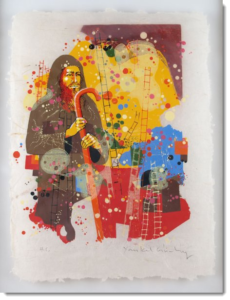Symbolism in Jewish Art

“Prophet Amos” Limited Edition Print by Yankel Ginzburg on Handmade Paper
Jewish art is a prominent art genre that has existed for thousands of years. It is built upon a heritage of symbols meaningful and unique to Jewish history. One can categorize Jewish art in several ways: Jewish folk art, creative renditions of ritualistic or historical art, and art by Jewish people. See the history of symbolism in Jewish art below, and check out the rich Jewish art featured in the Zimmerman Limited Editions gallery!
Jewish Art in Biblical Times
Jewish art began many centuries ago, as far back as at least the times of ancient Egypt. The most recognized event of initial Jewish art is the instructions to Bezalel for building the tabernacle. In the Old Testament, God gave instructions on exactly how to build the tabernacle and all the ritualistic elements to place inside it; every component of the tabernacle had symbolism.
Jewish Art A.D.
Israel continued to create art based on those symbols and other Old Testament symbols at least starting in the early 1st century. Today, we still have plenty of artifacts of Jewish art spanning the centuries, some biblical and some historic. Biblical symbolism in Jewish art includes the menorah, the dove and olive branch, the lion of Judah, the Torah scroll, the Star of David, and the hand symbol of the Levitic line of Cohen.
Hebrew writing also plays a large role in Jewish art. Often, you might see a Hebrew word, phrase, or sentence arranged on the same page as the visual art. Hebrew words become a part of the art itself and add to the significance of each piece. With Hebrew letters having numerical equivalents, the symbolism in Jewish art builds even more.
Jewish art has always existed, but Jewish artists began to gain position and prestige, especially from the Enlightenment onward, when Christendom began to decline and the Jews left the ghettos designated for them.
Jewish Art Today
Today, Jewish art comes in many forms. One can find Jewish artists who created art current with the times, such as Yaacov Agam, internationally known for his colorful kinetic art. Ya’akov Ne’eman, another 20th-century artist, is famous for his papercutting artwork. Yet another great example is Yankel Ginzburg, whose artwork is pictured above. In much of their art, one can see the richness of their heritage through symbolism, even today.
Contact Zimmerman Fine Art Today!
Since 1979 Zimmerman Editions Ltd. has worked closely with many internationally acclaimed artists to execute editions of their most unique images. Collaborating directly with the artists, Zimmerman Editions’ atelier has printed, fabricated, and published many special limited editions of fine art, including both prints and sculptures. All images have been faithfully produced to meet the artists’ most exacting requirements. Many of these high-quality art prints and objets d’art are represented in public and private collections around the world.
If you are a fine art dealer or marketer, or interested in collecting contemporary fine art, contact us today through our short form or our number at 888-484-1850. For more about fine art, keep in touch through Facebook, Twitter, and LinkedIn!
